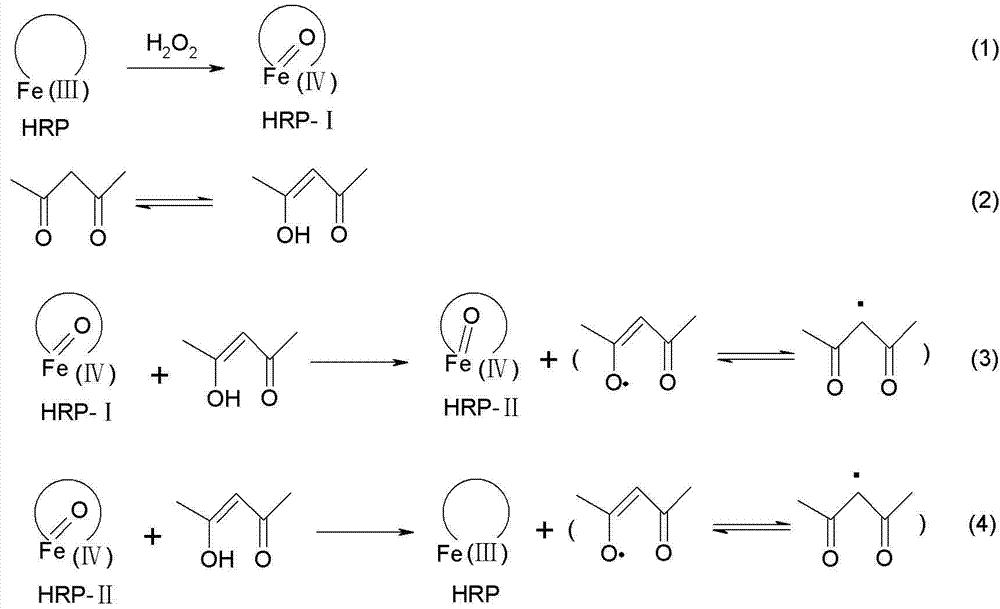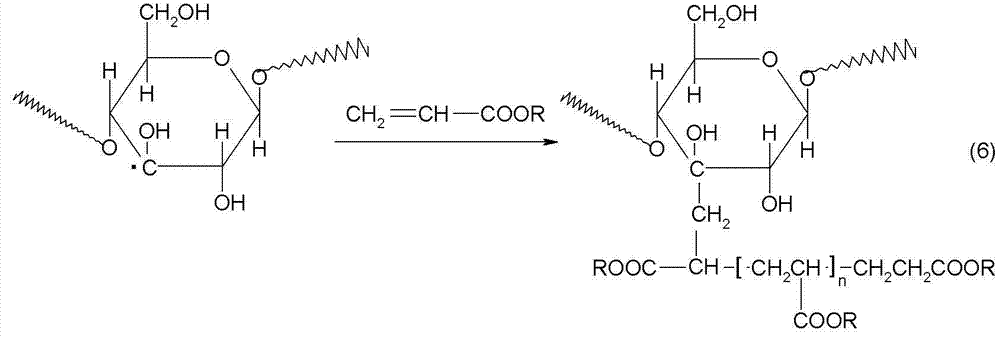Method for producing modified starch size through bio-enzyme
A technology of modified starch and a manufacturing method, which is applied in the directions of fiber processing, textile and papermaking, fermentation, etc., can solve the problems of difficult separation of grafted starch products, low product grafting efficiency, expensive initiators, etc., and shorten the sizing processing time. , Avoid the drastic change of system viscosity and the effect of easy product separation
- Summary
- Abstract
- Description
- Claims
- Application Information
AI Technical Summary
Problems solved by technology
Method used
Image
Examples
Embodiment 1
[0030] Weigh 8.5 g of acrylic acid, add 20% NaOH solution to neutralize the pH of the solution to 5-7, and prepare sodium acrylate solution. The prepared sodium acrylate solution was mixed with 160 g of 40% acrylic acid solution as grafted monomer mixture. Add 500 g of ordinary potato starch into deionized water to make starch milk containing 30% starch, put it into an ultrasonic processor at room temperature, raise the temperature to 40°C, turn on the ultrasonic treatment for 20 minutes, and adjust the pH value to 4-6 with acetic acid. Add 1 g of debranching enzyme, stir evenly, keep warm at 40 °C for 5 h, then raise the temperature to 80 °C for 30 min to inactivate the debranching enzyme. Add aqueous sodium bicarbonate solution to the prepared starch milk, adjust the pH value of the reaction system to 8-9, and pass nitrogen gas for 20 min to remove dissolved oxygen in the solution. Weighed 25 g of acetylacetone and 250 mL of HRP with a concentration of 1 mg / L and mixed them...
Embodiment 2
[0033] Weigh 62 g of acrylic acid and 13 g of butyl acrylate and mix them uniformly as a graft comonomer. Add 500 g of ordinary cornstarch into deionized water to make starch milk containing 30% starch, put it into an ultrasonic processor at room temperature, raise the temperature to 40 °C, turn on the ultrasonic treatment for 20 minutes, and adjust the pH value to 4-6 with acetic acid. Add 1 g of debranching enzyme, stir evenly, keep warm at 40 °C for 5 h, then raise the temperature to 80 °C for 30 min to inactivate the debranching enzyme. Add aqueous sodium bicarbonate solution to the prepared starch milk, adjust the pH value of the reaction system to 8-9, and pass nitrogen gas for 20 min to remove dissolved oxygen in the solution. Weighed 25 g of acetylacetone and 250 mL of HRP with a concentration of 1 mg / L and mixed them, then added them to the prepared starch milk, and added 30% HRP dropwise to the system at the same time. 2 o 2 Mix the solution with the acrylic monome...
Embodiment 3
[0036] 18 g of acrylic acid and 12 g of ethyl acrylate were weighed and mixed uniformly as graft comonomers. Add 200 g of ordinary cornstarch to deionized water to make starch milk containing 30% starch, put it in an ultrasonic processor at room temperature, raise the temperature to 40°C, turn on the ultrasonic treatment for 15 minutes, and adjust the pH value to 4-6 with acetic acid. Add 0.4 g of debranching enzyme, stir evenly, keep warm at 40°C for 3 h, then raise the temperature to 80°C for 20 min to inactivate the debranching enzyme. Add aqueous sodium bicarbonate solution to the prepared starch milk, adjust the pH value of the reaction system to 8-9, and pass nitrogen gas for 15 minutes to remove dissolved oxygen in the solution. Weighed 1 g of acetylacetone and 100 mL of HRP with a concentration of 1 mg / L and mixed them, then added them to the prepared starch milk, and added 30% HRP dropwise to the system at the same time. 2 o 2 Mix the solution with the acrylic monom...
PUM
| Property | Measurement | Unit |
|---|---|---|
| Viscosity | aaaaa | aaaaa |
| Adhesion | aaaaa | aaaaa |
| Viscosity | aaaaa | aaaaa |
Abstract
Description
Claims
Application Information
 Login to View More
Login to View More - R&D
- Intellectual Property
- Life Sciences
- Materials
- Tech Scout
- Unparalleled Data Quality
- Higher Quality Content
- 60% Fewer Hallucinations
Browse by: Latest US Patents, China's latest patents, Technical Efficacy Thesaurus, Application Domain, Technology Topic, Popular Technical Reports.
© 2025 PatSnap. All rights reserved.Legal|Privacy policy|Modern Slavery Act Transparency Statement|Sitemap|About US| Contact US: help@patsnap.com



